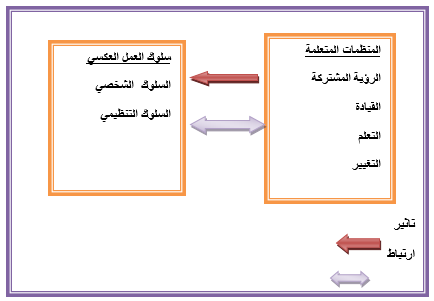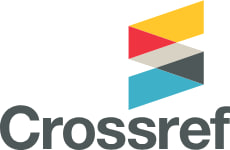The role of educated organizations in reducing counterfactual behavior
. An exploratory study of the opinions of a sample of teachers in the General Directorate of Education in Babil Governorate
Keywords:
learning organization, reverse work behaviourAbstract
Objective of the study: The current study seeks to identify the role of educated organizations with their four dimensions (shared vision, leadership, learning, change) in reducing counterproductive work behaviors by their dimensions (personal behavior, organizational behavior).
- Population and sample of the study / The study was carried out in the educational sector in a sample of teachers working in schools affiliated to the General Directorate of Education in Babil Governorate, where a sample of respondents was taken, amounting to (135) individuals.
- Problem and Questions of the Study/ The study focused on a main problem, which is "Do the educated organizations contribute to reducing the counter-work behavior of teachers in the Babel Education Directorate?"
- Contribution and importance of the study / The contribution of the study is to try to reduce the knowledge gap for the variables, as it focused on the role of educated organizations in reducing counterproductive behaviors. The importance of the study lies in that the variables (the learning organization and reverse work behavior) are important variables that directly affect the contemporary educational environment in particular and other organizations in general.
- Study methodology and tools / The study adopted the descriptive analytical approach in polling the opinions of respondents to describe and analyze the data of the study and then interpret it to reach practical results that depend on the sample’s answers to the study questions. The data was collected through the questionnaire, which in its paragraphs relied on the standards of previous studies, and the data was analyzed through a group through a number of statistical methods, including (arithmetic mean, standard deviation, Cronbach's alpha, impact factor, coefficient of determination) based on the (SPSS) program. And the program (Excel).
- The most important results / The study found a set of results, including the high level of the two main variables, and the study also found that educated organizations lead to the reduction of counterproductive work behaviors in those schools.
-The most important recommendations: The surveyed schools should pay attention to building and developing positive behaviors because of their impact on a set of organizational and behavioral outcomes such as organizational creativity, organizational ingenuity, organizational flexibility, job satisfaction, positive behavior, cooperation, and achieving advanced levels of performance.
References
• المصادر العربية
- السامرائي ،سلــوى هانـي والحسناوي ،علي عبد الحسن دلي .(٣٠١٦). نجناح ادارة المشروع في ضوء خصائـص المنظمة المتعلمة بحث ميداني لاراء عينة من العاملين في الهيئة العامة للطرق والجسور, مجلة العلوم الاقتصادية والادارية, المجلد(22) العدد(88).
- الكبيسي، اريج ميمون، (2013) درجة توافر أبعاد منظمة التعلم في المدارس الاساسية الخاصة في محافظة عمان وعلاقتها بالابداع الاداري للمديرين من وجهة نظر المعلمين، رسالة ماجساتير، كلية العلوم التربوية، جامعة الشرق االوسط.
- محمود، ناجي عبد الستار ودانوك، احمد عبد الله وياسين، مثنى سعدون، (2018) دور ثقافة الجودة في بناء المنظمة المتعلمة / دراسة استطلاعية لآراء عينة من القيادات الإدارية في جامعة كركوك/ جامعة تكريت،(المجلة العراقية للعلوم الادارية، المجلد(14) العدد(58).
• المصادر الاجنبية
Ahmad, N. H., Kudus, N., & Ahmad, S. S. S. (2021). Implementation of Learning Organization in School. Sains Humanika, 13(3).
Appelbaum S, Deguire K, Lay M, (2005),"The relationship of ethical climate to deviant workplace behaviour", Corporate Governance: The international journal of business in society, Vol. 5 NO. 4, pp. 43 – 55.
Bennett, R. J., Marasi, S., & Locklear, L. (2018). "Workplace deviance". In Oxford research encyclopedia of business and management.
Bennett, R.J. and Robinson, S.L. (2000), “Development of a measure of workplace deviance”, Journal of Applied Psychology, Vol. 85 No. 3, pp. 349-360
Christian, M., & Ellis, A. (2011). "Examining the effects of sleep deprivation on workplace deviance: A self-regulatory perspective". Academy of Management Journal, 54(5), pp. 913–934.
Fagbenro, D. A., & Olasupo, M. O. (2020). "Quality of Family Life and Workplace Deviant Behaviour with Perceived Competence as a Mediator among University Staff". Naše gospodarstvo/Our economy, 66(2), pp. 15-27.
Garvin, David A. 1993. Building a Learning Organization. Harvard Business Review, July-Aug, P 78-92.
Gautzm, D.P.,(2022).Status of the learning organization practices in the pharmaceutical industries of Nepal. Global Scientific Journal, 10)3).
Jeewandara, S.K., Kumari, D.A.T.(2021a)." A Theoretic Review Of Deviant Workplace Behavior." International Journal of Scientific and Technical Research ,10(4), pp.91-113.
Jelavic, s. R., & glamuzina, m. (2021). "Study on the Types of Deviant Workplace Behavior in Croatian IT Companies." The Journal of Organizational Management Studies, Vol. 2021,pp.1-15.
Johnson, Craig, Spicer , David & Wallace, James , 2011, " An Empirical Model Of The Learning Organisation",School Of Management, University Of Bradford, Pp(1-32).
Johnson, G., & Scholes, K., (2002), "Exploring Corporate Strategy: Text & Cases", Europe: 4th ed., prentice- Hall Inc.
Kish-Gephart, J. J., Harrison, D. A., & Treviño, L. K. (2010). "Bad apples, bad cases, and bad barrels: meta-analytic evidence about sources of unethical decisions at work". Journal of applied psychology, 95(1), pp. 1-31.
Kleiner, P:(2007), whyLearningorganizationsfile://1:Newfolder/why. L.o htm.
Liu, N.-T., & Ding, C. G. (2012). "General ethical judgments, perceived organizational support, interactional justice and workplace deviance". International Journal of Human Resource Management, 23(13),pp. 2712–2735.
Kalle Pajunen.,(2006),"The More Things Change, The More They Remain The Same? Evaluating Strategic Leadership in Organizational Transformations", Journal of Leadership, Vol.2, No.3, PP.353-367
Marasi, S., Bennett, R. J., Budden, H. (2018), “The Structure of an Organization: Does It Influence Workplace Deviance and Its' Dimensions? And to What Extent?”, Journal of Managerial Issues, 30(1): 8-28.
Muafi , (2011) . "Causes and Consequence Deviant Workplace Behavior." International Journal of Innovation, Management and Technology, Vol. 2, No. 2, April 2011
Načinović Braje, I., Aleksić, A., & Rašić Jelavić, S. (2020)." Blame it on individual or organization environment: what predicts workplace deviance more?." Social Sciences, 9(6), 99. PP.1-12.
Najafbagy, Reza & Doroudi, Homa, 2010, " Model Of Learning Organization In Broadcasting Organization Of Islamic Republic Of Iran", Serbian Journal Of Management, 5 (2) : 213 – 225.
Nasir, M., & Bashir, A. (2012). "Examining workplace deviance in public sector organizations of Pakistan". International Journal of Social Economics, 39(4), pp. 240–253
Oudejans, S.C.C., , 2009, " Routine outcome monitoring & learning organizations in substance abuse Treatment", Faculty Faculty of Medicine, University of Amsterdam. 23. Pedler, M., Burg.
Roy, L., Bastounis, M. & Minibas-Poussard, J. (2012). "Interactional justice and counterproductive work behaviour: The Mediating role of negative emotions". Social behaviour and personality, Journal of behaviour, 40(8), pp. 1341-1356.
Sackett, P. R., & DeVore, C. J. (2001). "Counterproductive behaviors at work". In. N. Anderson, DS Ones, HK Sinangil, & C. Viswesvaran (Eds.). Handbook of industrial, work and organizational psychology ,pp. 145-164.
Satpathy, I., Patnaik, B. C. M., & Mohanty, S. (2016). "Dynamics of Deviant Workplace Behaviour: A Literature Review". The International Journal Of Humanities & Social Studies, 4(5), 1-4
Senge, Peter M. (1990). The Fifth Discipline: The Art and Practice of the Learning Organization. New York: Doubleday.
Silins, Halia, Zarins, Silja & Mulford, Bill, 2002, "What Characteristics And Processes Define A School As A Learning Organisation? Is This A Useful Concept To Apply To Schools?", International Education Journal, Vol 3, No 1: Pp1-11.
Singh, Y. (2020). "Workplace Deviance: A Conceptual Framework." In Analyzing Workplace Deviance in Modern Organizations (pp. 1-22). IGI Global.
Soh, W. G., & Ali, M. B. (2021). Bibliometric Analysis of Learning Organization. Journal of Contemporary Issues in Business and Government, 27(1).
Sphr,,RW. 1999.Human Resource Management.NewJersy:Prentice Hall,Inc.
Toxopeus, Hanny, 2007, " A Primer On The Learning Organization", Prepared For The Public Service Learning Policy Directorate Canada Public Service Agency, Canada , Pp:1-31.
Senge ، Peter M.، (2004) ، The Art and Practice of The Learning Organization ، Publishing by Group، Inc ، USA.
Verma, U. K., Tripathi, R., Narayana, A., (2019). "Workplace Deviance: A Conceptual Framework." International Journal of Recent Technology and Engineering (IJRTE).8(4),PP. 12355-12364.
Silins, H., Zarins, S., & Mulford, B. (1998). What Characteristics and Processes Define a School as a Learning Organisation? Is This a Useful Concept To Apply to Schools?.
Walsh, G. (2014). "Extra- and intra-organizational drivers of workplace deviance". The Services Industries Journal, 34(14), pp. 1134–1153.
Yıldız, B., Alpkan, L., Sezen, B., & Yıldız, H. (2015). "A proposed conceptual model of destructive deviance: The mediator role of moral disengagement." Procedia-Social and Behavioral Sciences, 207, 414-423.
Zheng, Y., Huang, X., Graham, L., Redman, T., Hu, S. (2020a), “Deterrence Effects: The Role of Authoritarian Leadership in Controlling Employee Workplace Deviance”, Management and Organization Review, pp. 1-28.
Zheng, ZHAO Song & di, ZHANG Xiao,( 2008b), "An Empirical Study on Organizational Culture, Social Capital, Organizational Learning and Enterprise Knowledge Integration Capability", International Conference on Information Management, Innovation Management and Industrial.

Downloads
Published
How to Cite
Issue
Section
License
Copyright (c) 2024 سنان عليوي عباس

This work is licensed under a Creative Commons Attribution-NonCommercial-NoDerivatives 4.0 International License.
Authors retain the copyright of their papers without restrictions.









